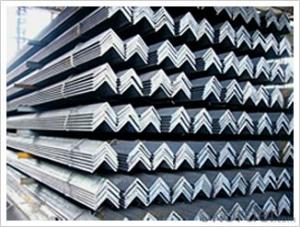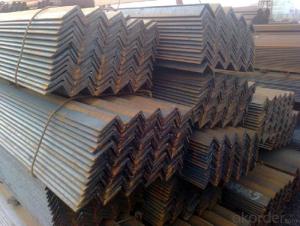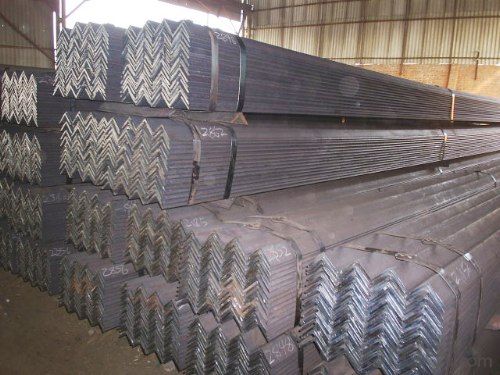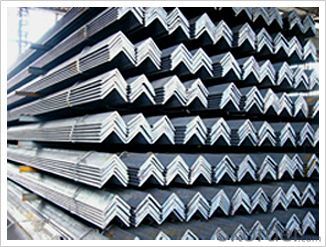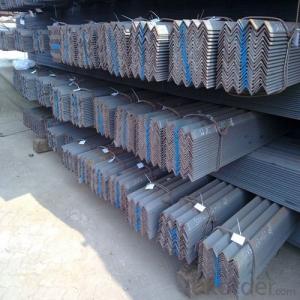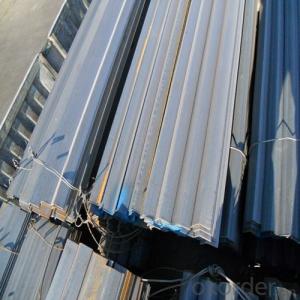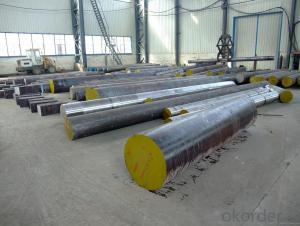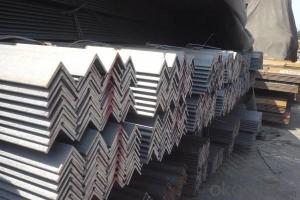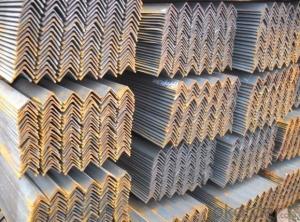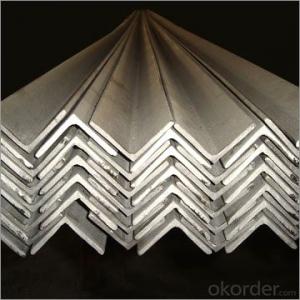Angel steel for construction about JIS SS400
- Loading Port:
- Tianjin
- Payment Terms:
- TT OR LC
- Min Order Qty:
- 25 m.t.
- Supply Capability:
- 10000 m.t./month
OKorder Service Pledge
OKorder Financial Service
You Might Also Like
Product Description:
Angle Steel Details:
| Minimum Order Quantity: | 25mts | Unit: | m.t. | Loading Port: | China Main Port |
| Supply Ability: | 80000-100000MTS/YEAR | Payment Terms: | TT or LC |
Product Description:
Specifications of JIS SS400 Angle Steel
1.Standards:GB,ASTM,BS,AISI,DIN,JIS
2.Invoicing on theoretical weight or actual weight as customer request
3.Material: JIS G3192,SS400;SS540.
4. Payment terms:
1).100% irrevocable L/C at sight.
2).30% T/T prepaid and the balance against the copy of B/L.
3).30% T/T prepaid and the balance against L/C
5.Sizes:
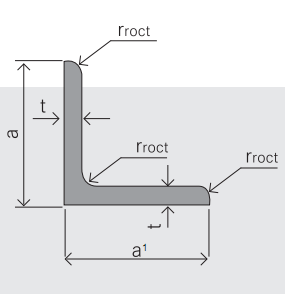
EQUAL ANGLES SIZES |
| ||
a(mm) | a1(mm) | thickness(mm) | length |
25 | 25 | 2.5---3.0 | 6M/12M |
30 | 30 | 2.5---4.0 | 6M/12M |
38 | 38 | 2.5 | 6M/12M |
38 | 38 | 3.0---5.0 | 6M/12M |
40 | 40 | 3.0---6.0 | 6M/12M |
50 | 50 | 3 | 6M/12M |
50 | 50 | 3.7---6.0 | 6M/9M/12M |
60 | 60 | 5.0---6.0 | 6M/9M/12M |
63 | 63 | 6.0---8.0 | 6M/9M/12M |
65 | 65 | 5.0---8.0 | 6M/9M/12M |
70 | 70 | 6.0---7.0 | 6M/9M/12M |
75 | 75 | 5.0---10.0 | 6M/9M/12M |
80 | 80 | 6.0---10.0 | 6M/9M/12M |
90 | 90 | 6.0---10.0 | 6M/9M/12M |
100 | 100 | 6.0---12.0 | 6M/9M/12M |
120 | 120 | 8.0-12.0 | 6M/9M/12M |
125 | 125 | 8.0---12.0 | 6M/9M/12M |
130 | 130 | 9.0-12.0 | 6M/9M/12M |
140 | 140 | 10.0-16.0 | 6M/9M/12M |
150 | 150 | 10---15 | 6M/9M/12M |
160 | 160 | 10---16 | 6M/9M/12M |
180 | 180 | 12---18 | 6M/9M/12M |
200 | 200 | 14---20 | 6M/9M/12M |
5. Material Specifications:
Grade | Yield Strength,N/mm² | Extension Strength N/mm² | |||
Thickness of Steel,mm | |||||
≦16 | >16-≦40 | >40-≦100 | >100 | ||
SS330 | ≧205 | ≧195 | ≧175 | ≧165 | 330-430 |
SS400 | ≧245 | ≧235 | ≧215 | ≧205 | 400-510 |
SS490 | ≧285 | ≧275 | ≧255 | ≧245 | 490-610 |
SS540 | ≧400 | ≧390 | - | - | ≧540 |
Usage & Applications Angle Steel
Trusses;
Transmission towers;
Telecommunication towers;
Bracing for general structures;
Stiffeners in structural use.
Packaging & Delivery of Angle Steel
1. Transportation: the goods are delivered by truck from mill to loading port, the maximum quantity can be loaded is around 40MTs by each truck. If the order quantity cannot reach the full truck loaded, the transportation cost per ton will be little higher than full load.
2. With bundles and load in 20 feet/40 feet container, or by bulk cargo, also we could do as customer's request.
3. Marks:
Color mark: There will be color marking on both end of the bundle for the cargo delivered by bulk vessel. That makes it easily to distinguish at the destination port.
Tag mark: There will be tag mark tied up on the bundles. The information usually including supplier logo and name, product name, made in China, shipping marks and other information request by the customer.
If loading by container the marking is not needed, but we will prepare it as customer request.
Production flow of Angle Steel
Material prepare (billet) —heat up—rough rolling—precision rolling—cooling—packing—storage and transportation

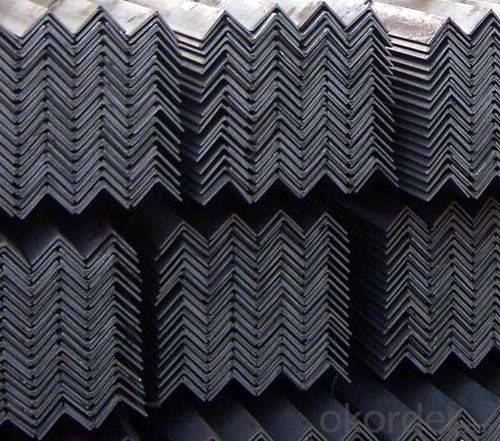
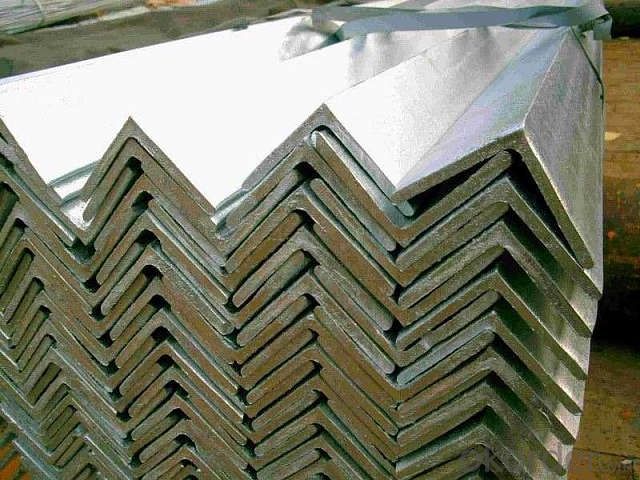
- Q: Bearing capacity of angle steel and channel steel
- Channel steel is a strip of steel with a cross section. Section steel with groove shape.Channel steel is a kind of carbon structural steel used for construction and machinery. It is a complex section steel. Its cross section has a groove shape. Channel steel is mainly used in building structure, curtain wall engineering, mechanical equipment and vehicle manufacturing, etc.. In use, it requires better welding, riveting performance and comprehensive mechanical properties. The raw material steel billet for channel steel is carbon or low alloy steel billets with a carbon content of not more than 0.25%. The finished channel steel is delivered by hot forming, normalizing or hot rolling. The specifications are expressed in millimeters of height (H) * leg width (b) * waist thickness (d), such as 100*48*5.3, which means waist height is 100 mm, leg width is 48 mm, waist thickness is 5.3 mm channel, or 10# channel steel. The same height of the channel, if there are several different leg width and waist thickness, also need to add a, B, C on the right side of the model to distinguish, such as 25#a, 25#b, 25#c and so on.Channel steel is divided into ordinary channel steel and light channel steel. Standard Specification for hot-rolled plain channel steel is 5-40#. Specifications for hot rolled flexible channel steel supplied by supply and demand agreement are 6.5-30#. Channel steel is mainly used for building structures, vehicle manufacturing, other industrial structures and fixed plates, cabinets, etc., and channel steel is often used in conjunction with i-beam.
- Q: How are steel angles used in structural framing?
- Steel angles are commonly used in structural framing as they provide stability and support. They are often used to reinforce corners and joints, adding strength to the overall structure. Steel angles are also used as braces and supports in various construction projects, helping to distribute weight and prevent sagging or collapsing.
- Q: How do you connect two steel angles together?
- Welding is a commonly used technique for connecting two steel angles. It involves melting the angles' edges and joining them using an electric arc or flame, resulting in a durable and permanent connection. Before welding, it is vital to clean the surfaces to remove any impurities or rust. Furthermore, accurately aligning the angles and securing them with clamps or tack welds is essential to guarantee a precise connection. Another alternative for joining steel angles is using bolts or screws. This approach entails drilling holes through the angles and then fastening them together with nuts and bolts or screws. To achieve a strong connection, it is crucial to choose appropriate fasteners and ensure they are tightly secured.
- Q: Can steel angles be used in the construction of parking garages?
- Yes, steel angles can be used in the construction of parking garages. Steel angles are commonly used as structural components in various construction applications, including parking garages. They provide strength, stability, and support for the overall structure and can be used for framing, bracing, and reinforcing. Steel angles are versatile and can be easily customized to meet the specific design requirements of parking garage construction.
- Q: What are the typical lengths of steel angles available in the market?
- The typical lengths of steel angles available in the market vary depending on the specific needs and requirements of the project. However, there are some common standard lengths that are readily available. These typically range from 20 feet to 40 feet, with incremental measurements such as 20 feet, 25 feet, 30 feet, 35 feet, and 40 feet. These lengths are commonly used in construction and industrial applications where steel angles are utilized for structural support, framing, and bracing purposes. It is important to note that customized lengths can also be obtained through special orders or fabrication, allowing for more flexibility in meeting specific project requirements.
- Q: What are the common methods of surface finishing for steel angles?
- The common methods of surface finishing for steel angles include galvanizing, painting, powder coating, and shot blasting.
- Q: How do you specify steel angles in drawings?
- To properly describe steel angles in drawings, it is necessary to specify several crucial factors. First and foremost, the dimensions of the angle must be clearly indicated. This can be achieved by specifying the lengths of the legs or the dimensions of the equal sides. For instance, an angle measuring 3 inches by 3 inches with a thickness of 1/4 inch would be denoted as a 3" x 3" x 1/4" angle. The type of angle should also be specified, whether it is L-shaped or unequal. This information is vital in determining the most suitable steel angle for a particular application. Furthermore, it is essential to indicate the grade of the steel angle. Steel angles are available in various grades, each possessing different levels of strength and durability. Common grades include A36, A572, and A588, among others. The grade is typically specified to ensure that the angle meets the required structural or mechanical properties. The length of the steel angle is another significant parameter that must be stated in the drawing. Whether it is a fixed length or a specific range, this information facilitates accurate fabrication and installation. Lastly, any additional requirements or specifications, such as surface finish, tolerance, or specific treatments or coatings, should be clearly stated in the drawing. This ensures that the steel angle is manufactured and installed according to the desired specifications. By including these parameters in the drawings, engineers, fabricators, and contractors can easily identify and procure the necessary steel angles for construction or manufacturing purposes with precision.
- Q: Are steel angles resistant to chemical corrosion?
- Steel angles have some resistance to chemical corrosion. Although steel is generally strong and durable, it can still corrode in the presence of certain chemicals and corrosive environments. However, steel angles are often treated or coated with protective materials like galvanization, which greatly improves their resistance to chemical corrosion. Galvanized steel angles have a zinc layer on their surface that acts as a barrier against corrosive substances. This coating helps prevent direct contact between the steel and chemicals, reducing the risk of corrosion. It's important to note, though, that the level of resistance may vary depending on the specific chemical, as well as the duration and intensity of exposure. To ensure long-term corrosion resistance, regular maintenance and inspection of steel angles are necessary.
- Q: How do you calculate the moment resistance of a steel angle?
- The moment resistance of a steel angle can be calculated by determining the plastic section modulus of the angle and multiplying it by the yield strength of the steel.
- Q: What are the different surface treatments for steel angles?
- Some common surface treatments for steel angles include galvanizing, painting, powder coating, and plating.
Send your message to us
Angel steel for construction about JIS SS400
- Loading Port:
- Tianjin
- Payment Terms:
- TT OR LC
- Min Order Qty:
- 25 m.t.
- Supply Capability:
- 10000 m.t./month
OKorder Service Pledge
OKorder Financial Service
Similar products
Hot products
Hot Searches
Related keywords

